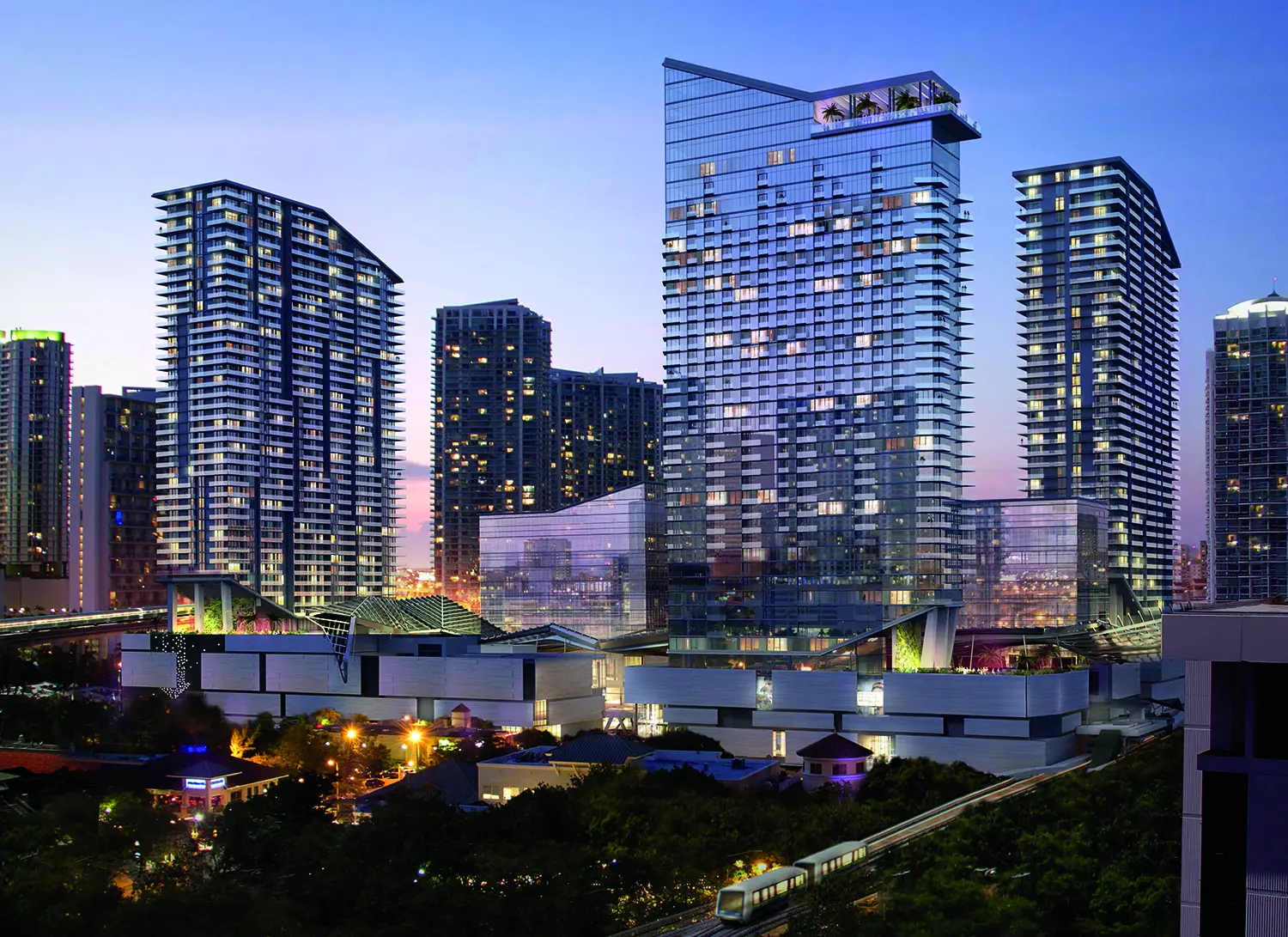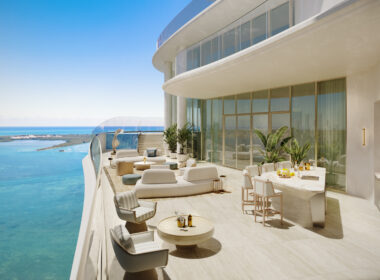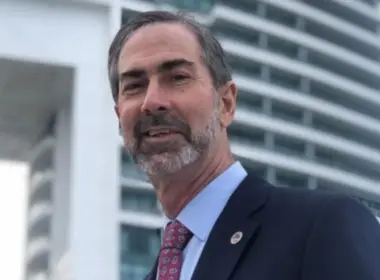For decades, Arquitectonica has broken the global mold with innovative designs
By Yousra Benkirane





Their designs have been associated with Miami ever since they first grabbed the world’s attention with the 1982 Atlantis Condominium, a 20-story rectilinear building with a glass façade and a five-story “palm court” cut out of the building like a square donut hole. It was featured in the opening montage of the popular “Miami Vice” television series, which defined Miami style at the time. Since then, Arquitectonica has become a global design powerhouse, producing prodigious quantities of modern structures. In Miami, their iconic landmarks include the Kaseya Center (formerly the American Airlines Arena), the dramatic Brickell City Centre, the newly updated Miami Beach Convention Center, and the Moss Cultural Center south of the city. As Arquitectonica’s reputation grew, the firm began to take on projects in other parts of the U.S. and around the world. One of the firm’s first major international projects was the Banco de Credito Headquarters in Peru, a full-circle moment for architect Bernardo Fort-Brescia, the Peruvian native who co-founded the firm and today remains its guiding force.





After Latin America, the firm expanded to Europe, charged with designing the Microsoft Headquarters in Paris. From there, Arquitectonica went on to design major projects throughout the U.S., Europe, Latin America, the Middle East, and Asia. Just to name a few: the Agricultural Bank of China Headquarters in Beijing (China); the International Finance Center Seoul (Korea); the Florida International University School of International and Public Affairs (Miami); the Dijon Performing Arts Center (France); the Landmark East building in Hong Kong (China); the BBVA Tower in Buenos Aires (Argentina); the Banco Real Santander headquarters in Sao Paulo (Brazil); the Wilkie D. Ferguson Jr. U.S. Courthouse (Miami); and the Sky Tower, Sun Tower, Gate Towers and Arc Tower in Abu Dhabi (United Arab Emirates). The list literally goes on and on, with more than 70 projects in the U.S. alone and another 70-plus around the world. “We like to do all types of projects because every project has a role in the evolution of society,” says Fort-Brescia.



Arquitectonica began in the late ’70s, born from a group of young architects who were struggling to find work after having just graduated. Founding principal Fort-Brescia was in his early 20s when he decided to move to Miami and begin teaching architecture at the University of Miami with co-founder and principal Laurinda Spear, after the two got married. Two years later, in 1977, Arquitectonica was founded in a small studio in Coconut Grove, along with Andrés Duany, Elizabeth Plater-Zyberk, and Hervin Romney. (Duany and Plater-Zyberk left in 1980, destined to become famous as pioneers of New Urbanism, and Romney left several years later.) In 1978, Arquitectonica built its first project, and within five years had designed a series of buildings that contributed to popularizing the idea of modern architecture. The company has since grown to some 400 employees with offices in New York City, Los Angeles, Madrid, Paris, Hong Kong, Shanghai, Manila, Dubai, São Paulo, and Lima.


The firm’s early projects were primarily in Miami, where Arquitectonica quickly gained a reputation for bold, colorful designs that stood out in the city’s skyline. One of their earliest projects, the Babylon Apartments, featured a striking zigzag design that became an instant landmark. Another early project, the Pink House, features a bright pink façade that remains an iconic feature of the Miami Beach landscape. “We find business projects that are really transformative for our city,” says Fort-Brescia. “Like putting the arena in the middle of Downtown on the water,” he continues, describing the thought process behind the placement of the Kaseya Center; instead of building in the outskirts, where arenas are usually located, he wanted to keep people in the city.
The Miami-born architecture and design firm, which introduced glass, steel, color, and pattern to a city best known for its Art Deco hotels along the beach, never planned any of this. “We never thought we would be a global firm. Things sort of just happened,” says Fort-Brescia. “We took advantage of the moments and took it beyond the initial opportunities, but we grew organically.” He provides the example of the firm’s office in Asia. When Arquitectonica was awarded a large project in Hong Kong, they saw a future in the region. In 1998, a Chinese-born architect offered to open their first office in China. That office now employs 100 architects and has opened two additional offices in the region, one of the earliest American businesses working in China. “We were very daring,” says Fort-Brescia. “But it was interesting because we liked the people, and the clients were reliable. So, we wanted to provide the service, not because we had a great plan, but because we are based on people. The decisions were made organically.”


Fort-Brescia credits the firm’s success to its employees. “The key thing is that our staff is passionate about what they do. I think part of our personality comes from that passion.” Arquitectonica uses a collaborative approach to design. Its architects, planners, and designers work together closely to develop innovative solutions for each project, drawing on a wide range of perspectives and expertise. From Shanghai to Dubai, the firm’s locally grounded employees know what the latest trends are, how people live, how the market is, and even the construction culture of the region. Each office has rooms equipped with visualizers – a camera that looks down on drawings being created by an architect. All offices can interact with real-time sketches 24/7 from their computers. According to Fort-Brescia, another key to the global firm’s success is its birthplace– Miami. “We love our city, and we keep our [headquarters] here because we owe it to Miami. The success of the firm arrived from the success and the activity of this city.” The architect also notes how easy it is to recruit young architects to the Magic City. “Everybody wants to move and work here. Miami was a great choice… We’re known as the firm from Miami.” For Fort-Brescia the quality of living was also a huge factor in the decision to keep their global HQ in Miami. “People in Miami are always smiling, have very good attitudes, and are hard-working. It’s a very pleasant lifestyle here. And for us, it’s important that our staff is happy with the office and outside it.”



While the firm will continue to design and build globally, the founder looks forward to the next few years in Miami. Currently under construction is the curvilinear MSC Cruises terminal at PortMiami. Then there is the forthcoming 1,000-foot super tower: One Brickell City Centre. When completed, the project will bring 1.7 million-square-feet of Class A office space to Miami’s Financial District and will be the tallest non-residential tower in Florida. Most recently, Arquitectonica won the approval to design a new luxury hotel at Miami International Airport. “There are [projects] coming that will change the skyline and change the nature of the city,” says Fort-Brescia.


The firm has also changed the nature of modern architecture with the colorful, curvy, and playful designs that have redefined the industry. Arquitectonica became “a representation of the new international style,” says Plater-Zyberk, who, after leaving Arquitectonica, went on to become the dean of the University of Miami School of Architecture. “When they started out, many architects were looking back historically for influences. Arquitectonica looked back to early modernism in Miami and South America, and the influences worthy of mining. It had to do with both climate and culture – Morris Lapidus and the architects of Miami Beach, and the Brazilian modernists. That was part of their background and their clearly global approach to modern design.”
Adds Plater-Zyberk: “Their work is a very important part of the modern history of our era. In addition to that, it’s often very clever. They do interesting floor plans, and the interior space can be quite amazing. Each [building] is somehow representative of its place but it doesn’t replicate. It’s constantly innovative.”












